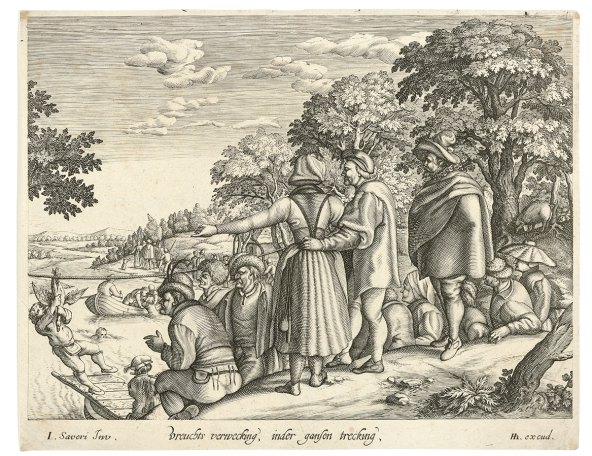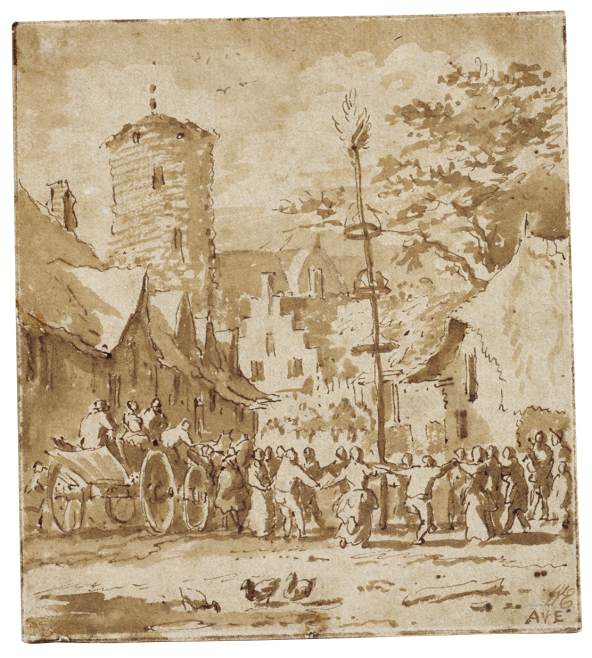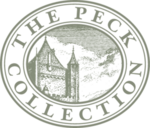Choose a background colour
Allaert van Everdingen, Dutch, 1621-1675
:
Villagers Playing Pulling-the-Goose, c. 1650
Pen and brown ink and brown wash on paper; framing lines in brown ink over black chalk.
4 × 3 9⁄16 in. (10.2 × 9.1 cm)
Recto, lower right, signed by the artist with his monogram, in pen and brown ink, AVE.
- Chain Lines:
- Vertical, 25|28|24 mm.
- Watermark:
- None.
- Provenance:
Alexander Mangin, 1732 – 1802, Dublin (Lugt 1341); his sale, London, 29 March 1810 and 14 following days, lot 826 (One, Riding to Fair, £3,2s. to Marquis Lansdowne); Henry Petty-Fitzmaurice, Third Marquess of Lansdowne, 1780 – 1863, Bowood, Wiltshire; sale (“Property of a Nobleman”), Christie’s, Amsterdam, 22 November 1982, lot 168 (‘from an early nineteenth-century English album); Sheldon and Leena Peck, Boston (Lugt 3847); gift to the Ackland Art Museum, inv. no. 2017.1.30.
- Literature/Exhibitions:
F. Robinson in Chapel Hill, Ithaca & Worcester 1999 – 2001, 48 – 49, no. 7; Davies 2007, 108, 384, no. 572; Stefes 2011, vol. 1, 218, under nos. 314 – 15.
- Ackland Catalogue:
- 2017.1.30
In this finished drawing, prolific draftsman Allart van Everdingen depicts pulling-the-goose, a game often played on festive days in local communities. Galloping riders on horseback attempted to wring the neck of a live and sometimes greased goose strung up across a road. Cruel for the animal, but entertaining for seventeenth-century participants, the pastime existed in a number of variants and is still performed today in part of the southern Netherlands, although with an artificial goose.
Everdingen’s scene belongs to a set of four drawings that may represent the seasons, aimed at the flourishing collectors’ market. But since pulling-the-goose is a rare subject and not closely tied to a particular season, it is difficult to determine an exact time of year for this depiction.
Allaert van Everdingen was one of the foremost landscape artists in his day, whose trip to Norway and Sweden early in his career stimulated his foremost specialty, Scandinavia-inspired scenery.1
His paintings, drawings, and etchings are replete with craggy mountains, waterfalls, and rustic log dwellings. These Nordic landscapes made him quickly popular among Dutch collectors and proved to have a lasting impact on, among others, Jacob van Ruisdael (1628/29 – 1682). The present work, however, demonstrates how he turned his eye toward the local Dutch scene. This is especially the case in his drawings, which also compose the most prolific side of his output with over 650 sheets known today.2
Almost all of these are finished works, signed with his monogram and intended for the flourishing collectors’ market for works on paper at the time. The enthusiasm among collectors continued into the eighteenth century, when his drawings were eagerly sought and regularly achieved high prices at auction.3
This drawing of a game of pulling-the-goose (ganstrekken) offers a unique example of this subject in Van Everdingen’s oeuvre. Though cruel for the animal, this festive (for its seventeenth-century participants) pastime involved stringing up a live and sometimes greased goose across a road, under which riders galloped and attempted to wring its neck. The game, which existed in a number of variants, was especially popular in the Low Countries.4
Images of the sport have occasionally made their way into the visual arts, for example in an engraving after the design of Jacob Savery (1565/67 – 1603) showing an early version on water using boats, with the caption “Merriment to be had from goose-pulling” Fig. 46.1.5

Andries Stock, after Jacob Savery, Goose-Pulling, c. 1614 – 48. Engraving, 180 × 228 mm. Amsterdam, Rijksmuseum, inv. no. RP-P-2001-54.
Rijksmuseum, Amsterdam
In contemporary Dutch literature, it makes an appearance in one of the most popular songs by Gerbrand Bredero (1585 – 1618), his 1622 Boerengeselschap, in which a goose-pulling in the village of Vinkeveen ends in a deadly brawl, a reminder for the townspeople to stay away from such rural festivities.6
In the nineteenth century, the folklorist Jan ter Gouw (1814 – 1894) reported that an already-dead goose might be used in place of a live one in order to reduce the element of cruelty, though a farmer once told him that he did not see the point in pulling a dead goose.7
The game still survives today in parts of Limburg with an artificial goose in place of a live or dead one.
One intriguing and rarely observed aspect of the Peck drawing is the presence of women riding on horseback with the participants, with one behind each of the three male riders who have lined up in the foreground to prepare their run. A rare painting by an unidentified seventeenth-century Dutch artist elucidates the women’s role, revealing that they are the main participants in the goose-pulling competition Fig. 46.2.

Pulling-the-Goose [detail], c. 1650 – 75. Oil on canvas, 99 × 138.5 cm. Christie’s, London, 13 July 2001, lot 82.
Christie’s, 2001
In the painting, each male rider keeps one hand on the reins and the other around his companion’s waist to provide additional support. For farmers and their wives, the wringing of poultry necks was likely not a gendered activity when it came to day-to-day tasks, but the relative equality afforded to women here as active participants in such a sport certainly seems ahead of its time.
In her catalogue of Van Everdingen’s drawings, Alice Davies speculates that this work may have once been part of series of drawings of the Twelve Months, in which each drawing offers a representative example of a labor or leisure activity for each month of the year.8
The supposition is reasonable since Van Everdingen likely created more sets of the Twelve Months theme than any other artist of his era.9
He did so only in the medium of drawing, rather than designing series of prints (which had long been the norm), though earlier printed series clearly served as inspiration for much of his subject matter.10
Six complete sets with twelve drawings of the Twelve Months theme by Van Everdingen are known today.11
Davies identified at least six further incomplete sets, with various months missing after sets were broken up over the years.12
Drawings in the Fogg Museum, Spencer Museum of Art, and the Hamburger Kunsthalle have been mentioned as possible missing “mates” for the present sheet, but they are slightly too wide, and almost certainly once belonged to one or more separate series.13
Three other drawings, however, more properly match this one in size and style.14
Formerly in private collections, the locations of all three are currently unknown, but they depict subjects that could easily be fitted into a traditional months-themed format: cattle driving, plowing, and a maypole celebration Fig. 46.3.

Allaert van Everdingen, Dancing around a Maypole in a Village Square, c. 1650 – 65. Pen in brown ink, brown wash, over traces of black chalk on paper, 103 × 92 mm. Private collection.
Lawrence Steigrad Fine Arts
There remains the problem of which month to assign the goose-pulling scene, since it had never been used before (by Van Everdingen or any other artist) for a series of Twelve Months, as far as is known.15
Although goose-pulling regularly took place during kermis, an annual festival or fair held locally throughout the country, every village would hold theirs at a different time throughout the year, making it impossible to pinpoint a month for this subject as a kermis festivity.16
Early sources also mention that goose-pulling was a popular activity on Koppermaandag, or “Copper Monday,” a day of charity and festivities which took place on the first Monday after Twelfth Night, or Driekoningenavond (Three Kings Eve) on January 6, a time of year more in keeping with the bare trees evident in this drawing.17
Rather than an incomplete set of the Twelve Months, the time of year presented in the Peck drawing and the three related sheets suggest they belong instead to a complete set of Four Seasons, a theme that Van Everdingen also treated on occasion.18
While the maypole celebration might seem to duplicate the springtime constituent offered by the plowing image, maypole dances were also carried out to celebrate summer, and in some places in the Low Countries took place in the summer months.19
Like the goose-pulling scene, a maypole celebration was atypical (and perhaps even unprecedented) for a Twelve Months or Four Seasons series, yet these drawings appear to have functioned as a group rather than independent works, especially given their small scale and similarly loose handling. Though this proposal is tentative due to the rarity of the iconography for cycle-of-time-themed series, these drawings serve as some of the best examples of Van Everdingen’s innovative capacity to create new variations of his genre subjects for such series of drawings.
End Notes
For an overview of Van Everdingen’s life and career, see Davies 1978, 28 – 60; and Davies 2001, 15 – 39.
See Davies 2007 for a complete catalogue of drawings. Despite the number that survive, only about two dozen drawings by Van Everdingen can currently be found in US public collections aside from the four in the Ackland Art Museum (all formerly in the Peck Collection). The largest group is the set of Twelve Months in the Spencer Museum of Art, University of Kansas (see Davies 1972; and Davies 2007, nos. 555 – 66).
Davies 2007, 19 – 30.
Ter Gouw 1871, 354 – 56; and Van Nijen 1934.
Hollstein, vol.23, no. 6.
Schenkeveld 1991, 80.
Ter Gouw 1871, 355; and Van Nijen 1934, 42.
Davies 2007, 108.
For a discussion of Van Everdingen’s Twelve Months series, see Davies 2007, 97 – 109. Davies does not explicitly state that the artist was responsible for more Twelve Months series than any other artist of his era, but it seems a safe statement, at least when considering seventeenth-century Dutch artists. For an overview of the Twelve Months theme in Dutch and Flemish art generally, see ‘s-Hertogenbosch & Leuven 2002 – 03.
Jan van de Velde II (1593 – 1641) was an important forerunner in the production of Twelve Months series and the development of a specifically Dutch iconography. He made three printed series of the subject early in his career, circa 1614 – 18; see Fucci 2018a, 161 – 98.
Davies 2007, nos. 457 – 528. The complete sets can be found in: De Grez Collection, Koninklijke Musea voor Schone Kunsten van België, Brussels (see S. Hautekeete in Brussels, Amsterdam & Aachen 2007 – 08, nos. 38 – 39); Kupferstichkabinett, Berlin (Bock & Rosenberg 1930, nos. 2325 – 36); Museum Boijmans Van Beuningen, Rotterdam; Pushkin Museum, Moscow (Sadkov 2010, nos. 159 – 70); Fodor Collection, Amsterdam Museum, Amsterdam (Broos & Schapelhouman 1993, no. 59); and Collection Dutuit, Petit Palais, Paris.
Davies 2007, nos. 529 – 74. See further Davies 1972 for a study of the set in the Spencer Museum of Art, University of Kansas, which was once an incomplete set that was “filled out” by an eighteenth-century collector with other drawings by Van Everdingen.
F. Robinson in Chapel Hill, Ithaca & Worcester 1999 – 2001, 48 (citing a 1988 letter by Alice Davies, curatorial files, Ackland Art Museum).
Davies 2007, nos. 570, 571, 572A.
See Davies 2007, 108, noting the problem of assigning a month to the Peck drawing.
For example, as shown in the engraving by Willem van Swanenburg, after David Vinkboons, from before 1612 showing “goose-cutting” (a variation of goose-pulling) in the background of a kermis scene; for which see the entry by G. Luijten in Amsterdam 1997, 104 – 07, no. 15; and Hollstein, vol. 37, no. 28.
Van Nijen 1934, 46. Analogously, in Catholic Flanders, goose-pulling would take place during carnival: see idem, 55, for the Ganzenrijderslied (Goose-Riders Song): “Wij rijden de Gans eens per jaar / En dat is juist met Carnaval” (We go goose-pulling once a year / And that is right during carnival).
See Davies 2007, 89 – 96, nos. 446 – 56.
Ter Gouw 1871Ter Gouw 1871, 132 – 46.
